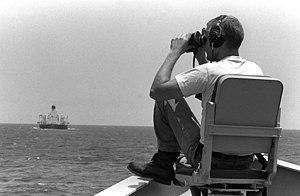Operation Earnest Will
| Operation Earnest Will | |||||
|---|---|---|---|---|---|
| Part of the Iran–Iraq War | |||||
 A US Navy sailor scans for mines from the bow of the guided missile frigate USS Nicolas (FFG-47) during an Operation Earnest Will convoy mission in June 1988 |
|||||
|
|||||
| Belligerents | |||||
|
|
|
||||
Operation Earnest Will (24 July 1987 – 26 September 1988) was the American military protection of Kuwaiti-owned tankers from Iranian attacks in 1987 and 1988, three years into the Tanker War phase of the Iran–Iraq War. It was the largest naval convoy operation since World War II.
The U.S. Navy warships that escorted the tankers, part of U.S. Naval Forces Central Command, were the operations' most visible part, but U.S. Air Force AWACS radar planes provided surveillance and U.S. Army special-operations helicopters hunted for possible attackers.
Other U.S. Navy vessels participated in Operation Earnest Will. They were then under the command of the U.S. Navy's Seventh Fleet which had primary responsibility for combat operations in the Persian Gulf region. The numerous ships used in Operation Earnest Will mostly consisted of Battleship Battle Groups, Carrier Battle Groups, Surface Action Groups and ships from the Pacific's Third and Seventh Fleets and the Mediterranean-based Sixth Fleet. They generally operated in and near the Gulf for parts of their normal six-month deployments.
This was the first tactical operation of the United States Special Operations Command (USSOCOM) that involved Navy SEALs, Special Boat Units, and 160th Special Operations Aviation Regiment (Airborne) ("Nightstalkers") aviators all working together.
...
Wikipedia
